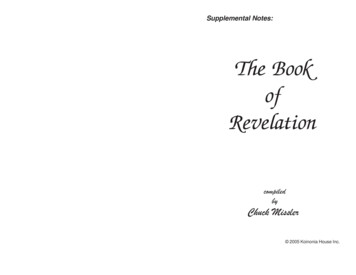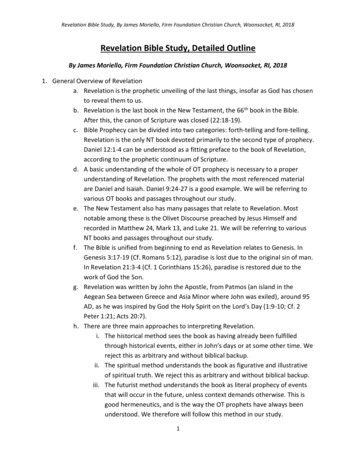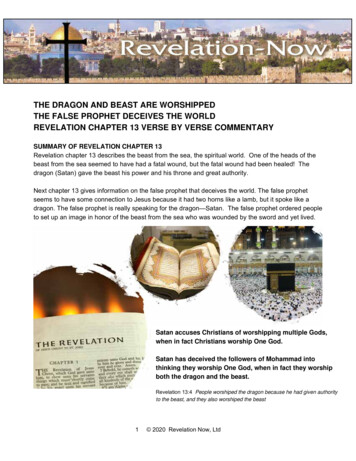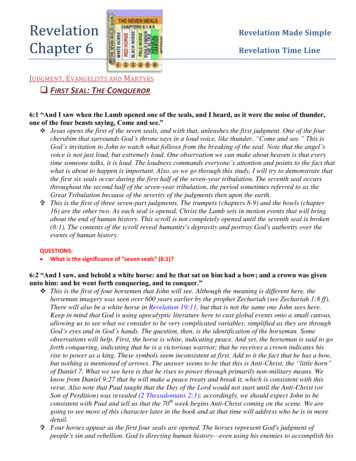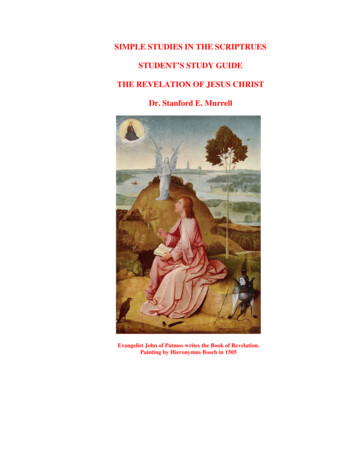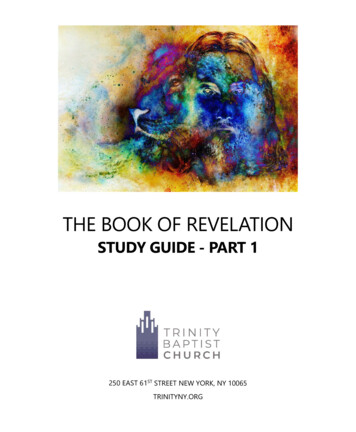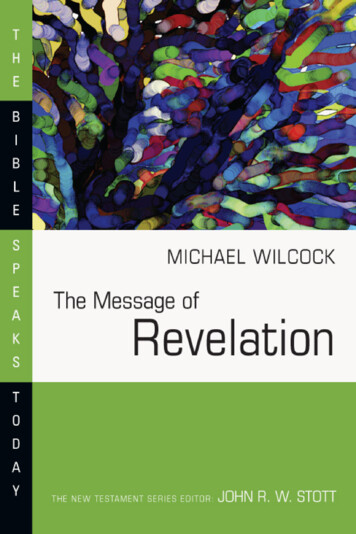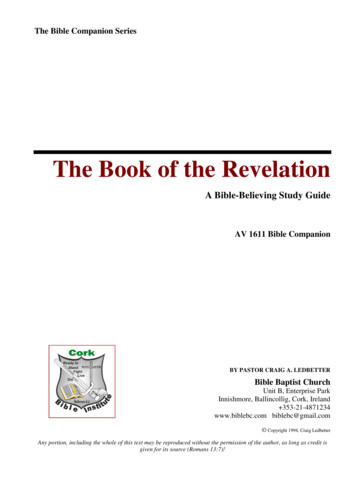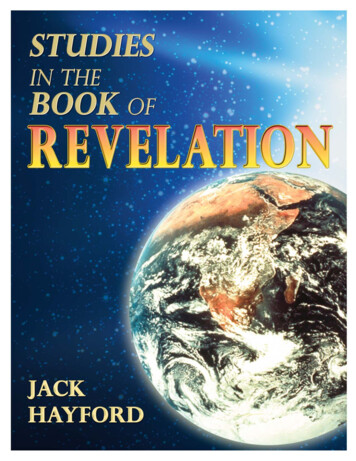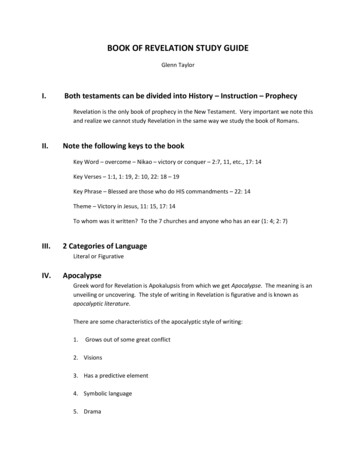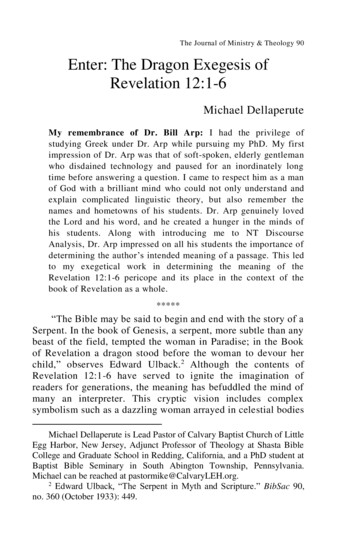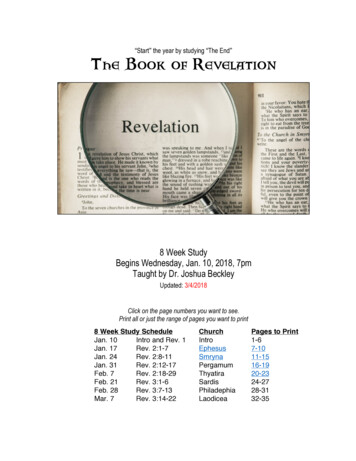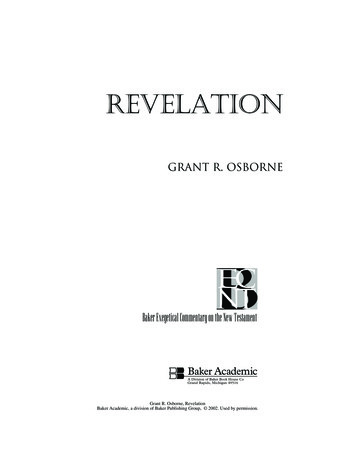
Transcription
Revelation.book Page iii Tuesday, August 20, 2002 4:10 PMREVELATIONGRANT R. OSBORNEBaker Exegetical Commentary on the New TestamentåGrant R. Osborne, RevelationBaker Academic, a division of Baker Publishing Group, 2002. Used by permission.
Revelation.book Page iv Tuesday, August 20, 2002 4:10 PM 2002 by Grant R. OsbornePublished by Baker Academica division of Baker Book House CompanyP.O. Box 6287, Grand Rapids, MI 49516–6287Printed in the United States of AmericaAll rights reserved. No part of this publication may be reproduced, stored in a retrieval system,or transmitted in any form or by any means—for example, electronic, photocopy, recording—without the prior written permission of the publisher. The only exception is brief quotations inprinted reviews.Library of Congress Cataloging-in-Publication DataOsborne, Grant R.Revelation / Grant R. Osborne.p. cm. — (Baker exegetical commentary on the New Testament)Includes bibliographical references and indexes.ISBN 0–8010-2299-1 (cloth)1. Bible. N.T. Revelation—Commentaries. I. Title. II. Series.BS2825.53 .O73 2002228p.07—dc212002023958For information about Baker Academic, visit our web site:www.bakeracademic.comGrant R. Osborne, RevelationBaker Academic, a division of Baker Publishing Group, 2002. Used by permission.
Revelation.book Page v Tuesday, August 20, 2002 4:10 PMTo my mentors:Wes GerigRichard LongeneckerClark PinnockI. Howard MarshallMy deepest appreciation for taking the rough granite of my lifeand sculpting what I am todayGrant R. Osborne, RevelationBaker Academic, a division of Baker Publishing Group, 2002. Used by permission.
Revelation.book Page vi Tuesday, August 20, 2002 4:10 rdisSmyrnaIconium CILICIATarsusASIAPhiladelphiaAthens aMediterranean eaGrant R. Osborne, RevelationBaker Academic, a division of Baker Publishing Group, 2002. Used by permission.
Revelation.book Page vii Tuesday, August 20, 2002 4:10 PMContentsMap viSeries Preface ixAuthor’s Preface xiAbbreviations xiiiTransliteration xixI.II.III.IV.V.VI.Introduction to Revelation 1Prologue (1:1–8) 50Churches Addressed (1:9–3:22) 77A. Inaugural Vision (1:9–20) 78B. Letters to the Seven Churches (2:1–3:22) 104God in Majesty and Judgment (4:1–16:21) 218A. God’s Sovereignty in Judgment (4:1–11:19) 219B. Great Conflict between God and the Forces of Evil (12:1–16:21) 451Final Judgment at the Arrival of the Eschaton (17:1–20:15) 603A. Destruction of Babylon the Great (17:1–19:5) 605B. Final Victory: The End of the Evil Empire at the Parousia(19:6–21) 669C. The Thousand-Year Reign of Christ and Final Destructionof Satan (20:1–10) 696D. Great White Throne Judgment (20:11–15) 719New Heaven and New Earth (21:1–22:5) 726A. Coming of New Heaven and New Earth (21:1–8) 728B. New Jerusalem as the Holy of Holies (21:9–27) 745C. New Jerusalem as the Final Eden (22:1–5) 768Epilogue (22:6–21) 777Works Cited 801Index of Subjects 825Index of Authors 828Index of Greek Words 834Index of Scripture and Other Ancient Writings 835Grant R. Osborne, RevelationBaker Academic, a division of Baker Publishing Group, 2002. Used by permission.vii
Revelation.book Page viii Tuesday, August 20, 2002 4:10 PMGrant R. Osborne, RevelationBaker Academic, a division of Baker Publishing Group, 2002. Used by permission.
Revelation.book Page ix Tuesday, August 20, 2002 4:10 PMSeries PrefaceThe chief concern of the Baker Exegetical Commentary on the New Testament (to be known as BECNT) is to provide, within the framework ofinformed evangelical thought, commentaries that blend scholarly depthwith readability, exegetical detail with sensitivity to the whole, attentionto critical problems with theological awareness. We hope thereby to attract the interest of a fairly wide audience, from the scholar who is looking for a thoughtful and independent examination of the text to the motivated lay Christian who craves a solid but accessible exposition.Nevertheless, a major purpose is to address the needs of pastors andothers involved in the preaching and exposition of the Scriptures asthe uniquely inspired Word of God. This consideration affects directlythe parameters of the series. For example, serious biblical expositorscannot afford to depend on a superficial treatment that avoids the difficult questions, but neither are they interested in encyclopedic commentaries that seek to cover every conceivable issue that may arise.Our aim, therefore, is to focus on those problems that have a directbearing on the meaning of the text (although selected technical detailsare treated in the additional notes).Similarly, a special effort is made to avoid treating exegetical questions for their own sake, that is, in relative isolation from the thrust ofthe argument as a whole. This effort may involve (at the discretion of theindividual contributors) abandoning the verse-by-verse approach in favor of an exposition that focuses on the paragraph as the main unit ofthought. In all cases, however, the commentaries will stress the development of the argument and explicitly relate each passage to what precedes and follows it so as to identify its function in context as clearly aspossible.We believe, moreover, that a responsible exegetical commentarymust take fully into account the latest scholarly research, regardless ofits source. The attempt to do this in the context of a conservative theological tradition presents certain challenges, and in the past the resultshave not always been commendable. In some cases, evangelicals appearto make use of critical scholarship not for the purpose of genuine interaction but only to dismiss it. In other cases, the interaction glides overinto assimilation, theological distinctives are ignored or suppressed,and the end product cannot be differentiated from works that arise froma fundamentally different starting point.Grant R. Osborne, RevelationBaker Academic, a division of Baker Publishing Group, 2002. Used by permission.ix
Revelation.book Page x Tuesday, August 20, 2002 4:10 PMSeries PrefaceThe contributors to this series attempt to avoid these pitfalls. On theone hand, they do not consider traditional opinions to be sacrosanct,and they are certainly committed to do justice to the biblical textwhether or not it supports such opinions. On the other hand, they willnot quickly abandon a long-standing view, if there is persuasive evidencein its favor, for the sake of fashionable theories. What is more important,the contributors share a belief in the trustworthiness and essential unityof Scripture. They also consider that the historic formulations of Christian doctrine, such as the ecumenical creeds and many of the documents originating in the sixteenth-century Reformation, arose from alegitimate reading of Scripture, thus providing a proper framework forits further interpretation. No doubt, the use of such a starting pointsometimes results in the imposition of a foreign construct on the text,but we deny that it must necessarily do so or that the writers who claimto approach the text without prejudices are invulnerable to the samedanger.Accordingly, we do not consider theological assumptions—fromwhich, in any case, no commentator is free—to be obstacles to biblical interpretation. On the contrary, an exegete who hopes to understand the apostle Paul in a theological vacuum might just as easilytry to interpret Aristotle without regard for the philosophical framework of his whole work or without having recourse to those subsequent philosophical categories that make possible a meaningful contextualization of his thought. It must be emphasized, however, thatthe contributors to the present series come from a variety of theological traditions and that they do not all have identical views with regard to the proper implementation of these general principles. In theend, all that really matters is whether the series succeeds in representing the original text accurately, clearly, and meaningfully to thecontemporary reader.Shading has been used to assist the reader in locating salient sectionsof the treatment of each passage: the introductory comments, the discussion of structure, and the concluding summary. Textual variants inthe Greek text are signaled in the author’s translation by means of halfbrackets around the relevant word or phrase (e.g., {Gerasenes}), therebyalerting the reader to turn to the additional notes at the end of each exegetical unit for a discussion of the textual problem. The documentationuses the author-date method, in which the basic reference consists ofauthor’s surname year page number(s): Fitzmyer 1981: 297. Theonly exceptions to this system are well-known reference works (e.g.,BAGD, LSJ, TDNT). Full publication data and a complete set of indexescan be found at the end of the volume.Moisés SilvaxGrant R. Osborne, RevelationBaker Academic, a division of Baker Publishing Group, 2002. Used by permission.
Revelation.book Page xi Tuesday, August 20, 2002 4:10 PMAuthor’s PrefaceThe purpose of this commentary is not only to provide the reader withexegetical and background information on the text but to help thereader trace the theological threads that tie the book together. Therefore, there is a great deal of intertextual data in the book, and on keywords I provide the reader with an overview of the term and relatedterms throughout the Apocalypse (I use “Apocalypse” and “Revelation”interchangeably for variety) along with theological commentary on thetheme in the book.Also, I want to make this a resource so that students can know wherescholarship divides on key issues. Thus I often have fairly lengthy listsof scholars with the various options on an exegetical debate. When I doso, I do not name the date and page number on which their view will befound, unless there is only one to a view or it is an article where the pagenumber is needed (then I follow the standard author-date format). Thereason is twofold: (1) in commentaries it is easy to find where a view isstated by looking up the discussion of the relevant verse, and (2) itwould be unnecessarily long and tedious to place all those dates andpage numbers in a list of (at times) ten or twelve names. It clutters upthe page and intimidates the reader.I have so many people to thank that it is difficult to know where tobegin. First, I wish to thank Trinity Evangelical Divinity School for giving me a sabbatical for this project. I also appreciate the kindness andthoughtful critique of my Baker editors, especially Wells Turner andMoisés Silva. Deep appreciation is due my teaching assistants whoworked so hard helping with research, compiling lists, and looking upmaterial: Sung-Min Park, Ben Kim, Dana Harris, Love Sechrest, Christine Poston, and Bill Myatt. It is impossible to say how many hours ofwork they saved me. Finally, I want to say thanks for the secretarial assistance of Judy Tetour, Heidi Harder, Susanne Henry, and ArleneMaas.Grant R. OsborneGrant R. Osborne, RevelationBaker Academic, a division of Baker Publishing Group, 2002. Used by permission.xi
Revelation.book Page xii Tuesday, August 20, 2002 4:10 PMGrant R. Osborne, RevelationBaker Academic, a division of Baker Publishing Group, 2002. Used by permission.
Revelation.book Page xiii Tuesday, August 20, 2002 4:10 PMAbbreviationsBibliographic and KJVLXXMMMTNA26NA27NASBNEBThe Anchor Bible Dictionary, edited by D. N. Freedman et al., 6 vols. (NewYork: Doubleday, 1992)American Standard VersionA Greek-English Lexicon of the New Testament and Other Early ChristianLiterature, by W. Bauer, W. F. Arndt, F. W. Gingrich, and F. W. Danker,2d ed. (Chicago: University of Chicago Press, 1979)A Greek-English Lexicon of the New Testament and Other Early ChristianLiterature, by W. Bauer, F. W. Danker, W. F. Arndt, and F. W. Gingrich,3d ed. (Chicago: University of Chicago Press, 2000)A Greek Grammar of the New Testament and Other Early Christian Literature, by F. Blass, A. Debrunner, and R. W. Funk (Chicago: University ofChicago Press, 1961)Baker Encyclopedia of the Bible, edited by W. A. Elwell, 2 vols. (GrandRapids: Baker, 1988)Dictionary of Jesus and the Gospels, edited by J. B. Green and S. McKnight(Downers Grove, Ill.: InterVarsity, 1992)Dictionary of the Later New Testament and Its Developments, edited byR. P. Martin and P. H. Davids (Downers Grove, Ill.: InterVarsity, 1997)Dictionary of Paul and His Letters, edited by G. F. Hawthorne and R. P.Martin (Downers Grove, Ill.: InterVarsity, 1993)Exegetical Dictionary of the New Testament, edited by H. Balz andG. Schneider, 3 vols. (Grand Rapids: Eerdmans, 1990–93)A Dictionary of the Bible, edited by J. Hastings, 5 vols. (New York: Scribners, 1909)The International Standard Bible Encyclopedia, edited by G. W. Bromileyet al., 4 vols. (Grand Rapids: Eerdmans, 1979–88)Jerusalem BibleKing James VersionSeptuagintThe Vocabulary of the Greek Testament: Illustrated from the Papyri andOther Non-Literary Sources, by J. H. Moulton and G. Milligan (reprintedGrand Rapids: Eerdmans, 1976)Masoretic TextNovum Testamentum Graece, 26th ed., edited by [E. and E. Nestle], K.Aland, M. Black, C. M. Martini, B. M. Metzger, and A. Wikgren (Stuttgart:Deutsche Bibelstiftung, 1979)Novum Testamentum Graece, 27th rev. ed., edited by [E. and E. Nestle], B.Aland, K. Aland, J. Karavidopoulos, C. M. Martini, and B. M. Metzger(Stuttgart: Deutsche Bibelgesellschaft, 1993)New American Standard BibleNew English BibleGrant R. Osborne, RevelationBaker Academic, a division of Baker Publishing Group, 2002. Used by permission.xiii
Revelation.book Page xiv Tuesday, August 20, 2002 4:10 PMAbbreviationsNIDNTT The New International Dictionary of New Testament Theology, edited byL. Coenen, E. Beyreuther, and H. Bietenhard; English translation editedby C. Brown, 4 vols. (Grand Rapids: Zondervan, 1975–86)NIDOTTE The New International Dictionary of Old Testament Theology and Exegesis,edited by Willem A. VanGemeren, 5 vols. (Grand Rapids: Zondervan,1997)NIVNew International VersionNJBNew Jerusalem BibleNKJVNew King James VersionNLTNew Living TranslationNRSVNew Revised Standard VersionNTNew TestamentOTOld TestamentOTPThe Old Testament Pseudepigrapha, edited by J. H. Charlesworth, 2 vols.(Garden City, N.Y.: Doubleday, 1983–85)PHILLIPS The New Testament in Modern English, by J. B. PhillipsREBRevised English BibleRSVRevised Standard VersionRVRevised VersionKommentar zum Neuen Testament aus Talmud und Midrasch, by H. L.SBStrack and P. Billerbeck, 6 vols. (Munich: Beck, 1922–61)TDNTTheological Dictionary of the New Testament, edited by G. Kittel and G.Friedrich; translated and edited by G. W. Bromiley, 10 vols. (Grand Rapids: Eerdmans, 1964–76)TEVToday’s English VersionTRTextus ReceptusThe Greek New Testament, 3d corrected ed., edited by K. Aland, M. Black,UBS3C. M. Martini, B. M. Metzger, and A. Wikgren (New York: United BibleSocieties, 1983)UBS4The Greek New Testament, 4th rev. ed., edited by B. Aland, K. Aland, J.Karavidopoulos, C. M. Martini, and B. M. Metzger (Stuttgart: DeutscheBibelgesellschaft/United Bible Societies, 1993)Hebrew BibleGen.Exod.Lev.Num.Deut.Josh.Judg.Ruth1 Sam.2 Sam.1 Kings2 Kings1 oshuaJudgesRuth1 Samuel2 Samuel1 Kings2 Kings1 Chronicles2 am.Ezek.2 siastesSong of hHaggaiZechariahMalachiGrant R. Osborne, RevelationBaker Academic, a division of Baker Publishing Group, 2002. Used by permission.
Revelation.book Page xv Tuesday, August 20, 2002 4:10 PMAbbreviationsGreek TestamentMatt.MarkLukeJohnActsRom.1 Cor.2 Cor.Gal.MatthewMarkLukeJohnActsRomans1 Corinthians2 CorinthiansGalatiansEph.Phil.Col.1 Thess.2 Thess.1 Tim.2 Tim.TitusPhilem.EphesiansPhilippiansColossians1 Thessalonians2 Thessalonians1 Timothy2 TimothyTitusPhilemonHeb.James1 Pet.2 Pet.1 John2 John3 JohnJudeRev.HebrewsJames1 Peter2 Peter1 John2 John3 JohnJudeRevelationOther Jewish and Christian WritingsAdam andEveAdd. Esth.Apoc. Abr.Apoc. Dan.Apoc. ElijahApoc. Mos.Apoc. Pet.Apoc. Zeph.Asc. Isa.Books of Adam and EveAdditions to EstherApocalypse of AbrahamApocalypse of DanielApocalypse of ElijahApocalypse of MosesApocalypse of PeterApocalypse of ZephaniahMartyrdom and Ascensionof IsaiahAs. Mos.Assumption of MosesBar.Baruch2 Bar.2 (Syriac Apocalypse of) Baruch3 Bar.3 (Greek Apocalypse of) BaruchBarn.BarnabasBelBel and the DragonBib. Ant.Pseudo-Philo, BiblicalAntiquities1–2 Clem.1–2 ClementDid.DidacheDiogn.DiognetusEccl. Hist.Eusebius, Ecclesiastical History1 Enoch1 (Ethiopic) Enoch2 Enoch2 (Slavonic) Enoch1 Esdr.1 Esdras2 Esdr.2 EsdrasHerm. Man. Shepherd of Hermas,Mandate(s)Herm. Sim. Shepherd of Hermas,Similitude(s)Herm. Vis.Shepherd of Hermas, Vision(s)Ign. Eph.Ignatius, Letter to the EphesiansIgn. Magn.Ignatius, Letter to theMagnesiansIgn. Phld.Ignatius, Letter to thePhiladelphiansIgn. Rom.Ignatius, Letter to the RomansJdt.Jos. As.Jub.Let. Arist.Let. Jer.1–4 Macc.Mart. Pol.Odes Sol.Pol. Phil.Pr. Azar.Pr. Man.Ps. Sol.Sib. Or.Sir.Sus.T. Abr.T. AsherT. Ben.T. DanT. GadT. IsaacT. Iss.T. JacobT. JobT. Jos.T. JudahT. LeviT. MosesT. Naph.T. Reub.T. Sim.T. Sol.T. Zeb.Tob.Wis.JudithJoseph and AsenethJubileesLetter of AristeasLetter of Jeremiah1–4 MaccabeesMartyrdom of PolycarpOdes of SolomonPolycarp, Letter to thePhilippiansPrayer of AzariahPrayer of ManassehPsalms of SolomonSibylline OraclesSirach (Ecclesiasticus)SusannaTestament of AbrahamTestament of AsherTestament of BenjaminTestament of DanTestament of GadTestament of IsaacTestament of IssacharTestament of JacobTestament of JobTestament of JosephTestament of JudahTestament of LeviTestament of MosesTestament of NaphtaliTestament of ReubenTestament of SimeonTestament of SolomonTestament of ZebulunTobitWisdom of SolomonGrant R. Osborne, RevelationBaker Academic, a division of Baker Publishing Group, 2002. Used by permission.xv
Revelation.book Page xvi Tuesday, August 20, 2002 4:10 PMAbbreviationsJosephus and PhiloAbr.Ag. Ap.Alleg. Interp.Anim.Ant.Chang. Nam.Cher.Conf. Tong.Cont. LifeCreat.Decal.DreamsDrunk.Etern. WorldFlacc.FlightGaiusGiantsGood FreeHeirHusb.Hypoth.On AbrahamAgainst ApionAllegorical InterpretationOn AnimalsJewish AntiquitiesOn the Change of NamesOn the CherubimOn the Confusion ofTonguesOn the ContemplativeLifeOn the CreationOn the DecalogueOn DreamsOn DrunkennessOn the Eternity of theWorldFlaccusOn Flight and FindingOn the Embassy to GaiusOn the GiantsEvery Good Person IsFreeWho Is the Heir of DivineThingsOn HusbandryHypothetica/Apology forthe JewsJos.J.W.LifeMigr. Abr.On JosephThe Jewish WarThe Life of JosephusOn the Migrationof AbrahamMos.On the Life of MosesPlant.On Noah’s Work as aPlanterPost. CainOn the Posterity andExile of CainPrelim. Stud.On the Preliminary StudiesProv.On ProvidenceQuest. Exod.Questions and Answerson ExodusQuest. Gen.Questions and Answerson GenesisRewardsOn Rewards and Punishments/On CursesSacr.On the Sacrifices of Abeland CainSobr.On SobrietySpec. LawsOn the Special LawsUnchang.On the Unchangeablenessof GodVirt.On the VirtuesWorse Att. Bet. The Worse Attacks theRabbinic TractatesThe abbreviations below are used for the names of tractates in the Babylonian Talmud(indicated by a prefixed b.), Palestinian or Jerusalem Talmud (y.), Mishnah (m.), andTosepta (t.). Abod. Zar.,Abot Arak.B. Bat.B. Mes.B. Qam.Bek.Ber.Bes.aBik.Dem. Ed. Erub.Git .H ag.H al.Hor.H ul.xvi Aboda Zara,Abot ArakinBaba, Batra,Baba, Mes.i a,Baba, Qamma,BekorotBerakotBes.aBikkurimDema,i Eduyyot ErubinGit t inH agigaH allaHorayotH ullinKel.Ker.Ketub.Kil.Ma asa.Ma asa. SH.Mak.Maks .Meg.Me il.Menah.Mid.Miqw.Mo ed Qat .NazirNed.Neg.Nid.KelimKeritotKetubotKil,ayimMa asaerotMa asaer SHeniMakkotMaks irinMegillaMe ilaMenah.otMiddotMiqwa,otMo ed Qat anNazirNedarimNega imNiddaGrant R. Osborne, RevelationBaker Academic, a division of Baker Publishing Group, 2002. Used by permission.
Revelation.book Page xvii Tuesday, August 20, 2002 4:10 PMAbbreviations,Ohol. Or.ParaPe,aPesah.Qid.Qin.Ro,s Has .SHab.Sanh.SHeb.SHebu.SHeqal.Sot a,Oholot OrlaParaPe,aPesah.imQiddus inQinnimRo,s Has s anaSHabbatSanhedrinSHebi itSHebu otSHeqalimSot aSuk.T . YomTa an.TamidTem.Ter.T ohar. Uq.Yad.Yeb.Yoma,Zab.Zebah.SukkaT ebul YomTa anitTamidTemuraTerumotT oharot rashim on the biblical books are indicated by the abbreviation Midr. appendedin front of the usual abbreviation for the biblical book (see the above list). The namesof other midrashim (e.g., Sipra, Mekilta de Rabbi Ishmael, Pesiqta Rabbati) arespelled in full.TargumimTargumim on the Writings and Prophets are indicated by the abbreviation Tg. appended in front of the usual abbreviation for the biblical book (see the above list). Inthe place of Tg., targumim on the Pentateuch use one of the following abbreviations:Frg. Tg.Tg. Neof. 1Tg. Onq.Tg. Ps.-J.Fragmentary TargumTargum Neofiti 1Targum OnqelosTargum Pseudo-JonathanQumran / Dead Sea ScrollsReferences follow the numbering system found in Florentino García Martínez, TheDead Sea Scrolls Translated: The Qumran Texts in English, 2d ed., translated by Wilfred G. E. Watson (Leiden: Brill; Grand Rapids: Eerdmans, 1996).1QHThanksgiving Hymns/Psalms (Hôdamyôt); reference numbers in parentheses reflect the older eighteen-column division1QMWar Scroll (Milh.ammâ)1QpHabCommentary (Pesher) on Habakkuk1QSManual of Discipline (Serek Hayyah.ad, Rule/Order of the Community)1QSaRule of the Congregation (1Q28a, appendix A to 1QS)1QSbRule of the Blessings (1Q28b, appendix B to 1QS)4QFlorFlorilegium (4Q174)4QPBlessPatriarchal Blessings (4Q252)Commentary (Pesher) on Genesis (4Q252)4QpGenaCommentary (Pesher) on Isaiah (4Q164)4QpIsad4QMMTHalakhic Letter (Miqsamt Ma absaê Tôrâ)Commentary (Pesher) on Psalms (A) (4Q171; formerly 4QpPs37)4QpPsa4QSHirSHabba Songs of the Sabbath Sacrifice (Serek SHîrôt Ôlat Has s abbamt)Grant R. Osborne, RevelationBaker Academic, a division of Baker Publishing Group, 2002. Used by permission.xvii
Revelation.book Page xviii Tuesday, August 20, 2002 4:10 monia (4Q175)Description of the New Jerusalem (5Q15)Melchizedek text (11Q13)Temple Scroll (11Q19)Damascus DocumentGreek ManuscriptsSigla for Greek manuscripts and other text-critical abbreviations basically follow thepattern in UBS4, pages 4*–52*, and NA27, pages 50*–76*. The original hand of amanuscript is indicated by an asterisk (Å*), successive correctors by superscriptnumbers (Å1, Å2, etc.).xviiiGrant R. Osborne, RevelationBaker Academic, a division of Baker Publishing Group, 2002. Used by permission.
Revelation.book Page xix Tuesday, August 20, 2002 4:10 PMGreek Transliterationaazzllppfphbbhemmmrrcchgg (n)qthnnsßsypswomÔhddiixxtteekkoouy (u)Notes on the transliteration of Greek1. Accents, lenis (smooth breathing), and iota subscript are notshown in transliteration.2. The transliteration of asper (rough breathing) precedes a vowel ordiphthong (e.g., aJ ha; aiJ hai) and follows r (i.e., rJ rh).3. Gamma is transliterated n only when it precedes g, k, x, or c.4. Upsilon is transliterated u only when it is part of a diphthong (e.g.,au, eu, ou, ui).Grant R. Osborne, RevelationBaker Academic, a division of Baker Publishing Group, 2002. Used by permission.xix
Revelation.book Page xx Tuesday, August 20, 2002 4:10 PMHebrew Transliterationabgdhwzjfy klµmˆns[πp xqrcvt,bgdhwzh.t yklmns ps.qrsas s.patah.furtive patah.sebgôls.erm êshort h.îreqlong h.îreq written defectivelyqammes. h.amt ûph.ôlem written fullyh.ôlem written defectivelys ûreqshort qibbûs.long qibbûs. written defectivelyfinal qammes. hem, (Hb; amh)sebgôl yôd (Yb, êy)s.erm ê yôd (Ybe êy)h. îreq yôd (Ybi îy)h. atm epm patah.h.atm epm sebgôlh.atm epm qammes.vocal s ebwam,silent s ebwam,tNotes on the transliteration of Hebrew1. Accents are not shown in transliteration.2. Silent s ebwâ, is not indicated in transliteration.3. The unaspirated forms of b g d k p t are not specially indicated in transliteration.4. Damges forte is indicated by doubling the consonant. Damges present for euphonious reasons is not indicated intransliteration.5. Maqqeµp is represented by a hyphen.xxGrant R. Osborne, RevelationBaker Academic, a division of Baker Publishing Group, 2002. Used by permission.
Revelation.book Page 1 Tuesday, August 20, 2002 4:10 PMIntroduction to RevelationThe Apocalypse is a difficult book to interpret, though easier on thewhole than the Gospels. This is because there are few source-criticalproblems to fight through. The primary problems in studying the Apocalypse are four: the symbolism; the structure of the book; the debateamong historicist, preterist, idealist, and futurist interpretations; andthe use of the OT in the book. The function of the symbolism is greatlydebated, especially in terms of its relation to the past (apocalyptic mindset behind the book), present (the events of John’s day), and future (future events in the history of the church or at the eschaton). This is, ofcourse, closely related to the schools of interpretation regarding thebook. The one area of general agreement among most commentators isthat the background is to be found in the common apocalyptic world ofJohn’s day. No one has yet come up with any outline that approachesconsensus. There are two further problems: the relation between theseals, trumpets, and bowls, and the lengthy interludes that interrupt theseals, trumpets, and bowls (7:1–17; 10:1–11:13; 12:1–14:20); these havenot been adequately accounted for in current structural hypotheses.The consensus interpretation among nonevangelicals is preterist. Inthe SBL (Society of Biblical Literature) seminar it is assumed that thebook uses a future orientation not to describe future reality but to challenge the situation of the original readers. However, conclusions mustcome via study of the apocalyptic genre. Do ancient Near East, OT, andintertestamental apocalypses take a futuristic or a preterist point ofview? I am convinced of two things: first that they are predominantly futuristic in perspective, and second that it is a disjunctive fallacy to takean either-or stance. A basic element in defining apocalyptic is its pessimism toward the present and the promise of restoration in a sovereignlycontrolled future. However, this does not mean that there is no preteristelement, for the message regarding God’s sovereignty over the future isintended to call the church in the present to perseverance, and many ofthe symbols in the Apocalypse are borrowed from the first-century situation, for example, the Roman Empire in chapters 17–18. The Antichristand his forces are depicted as the final Roman Empire, but there is atwofold message in this: the current empire will be judged by God, andthe final empire will be defeated and destroyed. In short, the book isboth preterist and futurist in orientation.Grant R. Osborne, RevelationBaker Academic, a division of Baker Publishing Group, 2002. Used by permission.1
Revelation.book Page 2 Tuesday, August 20, 2002 4:10 PMIntroduction to RevelationThe definitive work on the use of the OT in the Apocalypse has yet tobe written. It has no actual quotation yet far more allusions than anyother NT book. These allusions are as essential to understanding thebook as the symbolism. Virtually every point made comes in some wayvia an OT allusion. Contrary to popular opinion, the Book of Daniel isnot the key to the Apocalypse. Isaiah, Zechariah, and Ezekiel are foundalmost as often. The key interpretive element is typology. As in the Gospels with Jesus, now the current time of trouble and the final conflagration are presented as reliving and fulfilling the prophecies of the OT.AuthorshipInternal Evidence. The author of the book identifies himself as “John,the slave of (Jesus/God) . . . (exiled) on the island of Patmos” (1:1, 4, 9;22:8), and he is the recipient of a series of visions sent from God for thechurches of the Roman province of Asia. He is to provide prophetic“witness” to these churches of the message God is sending to themthrough him (1:2). Yet the identification of this “John” has led to centuries of disagreement on the part of scholars, for he never identifies himself as the “apostle” but simply calls himself “slave” (1:1), “prophet” (1:3;22:9), and one among his “brothers the prophets” (22:9; cf. 19:10). Therehave been several suggestions: (1) John the apostle; (2) the elder John;(3) John Mark; (4) John the Baptist; (5) another John; (6) Cerinthus; and(7) someone using the name of John the apostle as a pseudonym.Three can be dismissed rather quickly. Dionysius the Great, bishopof Alexandria in the mid–third century, thought it possible that JohnMark may have been the author but dismissed it as unlikely on historical grounds (Eusebius, Eccl. Hist. 7.25). The only one to suggest thatJohn the Baptist was the author was Ford (1975b: 28–41, 50–56), whobelieved John and his followers produced it in three stages: first, chapters 4–11 as visions given to the Baptist before Jesus began his ministry;then, chapters 12–22 by one of his disciples before A.D. 70; and, finally,chapters 1–3 by a final editor. However, no one has followed her because it is difficult to explain how such a work on the periphery of Christianity would be accepted into the Christian canon. Also, the GnosticCerinthus was proposed by two groups who opposed the Montanist
2002 by Grant R. Osborne Published by Baker Academic a division of Baker Book House Company P.O. Box 6287, Grand Rapids, MI 49516-6287 . First, I wish to thank Trinity Evangelical Divinity School for giv-ing me a sabbatical for this project. I also appreciate the kindness and thoughtful critique of my Baker editors, especially Wells .
